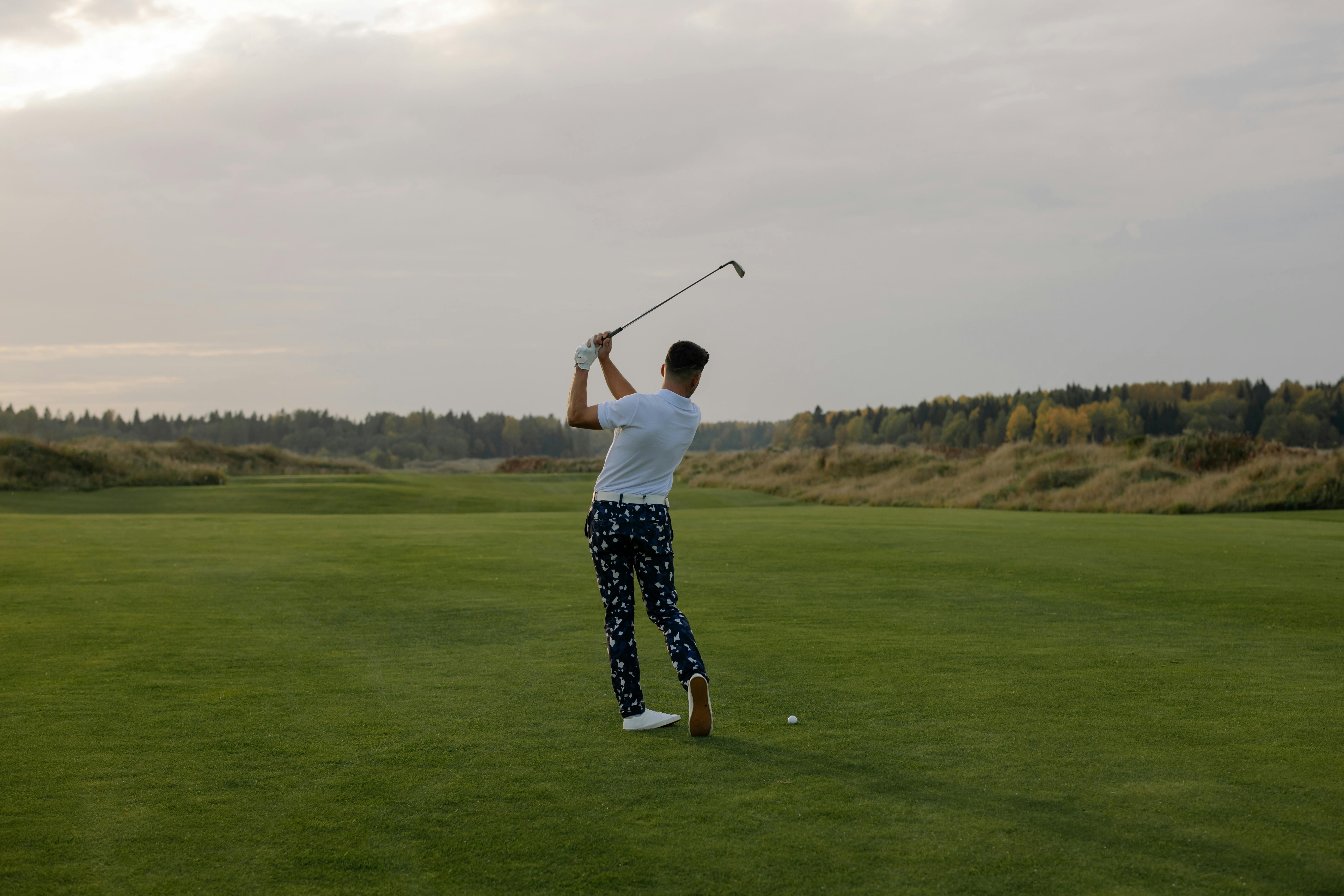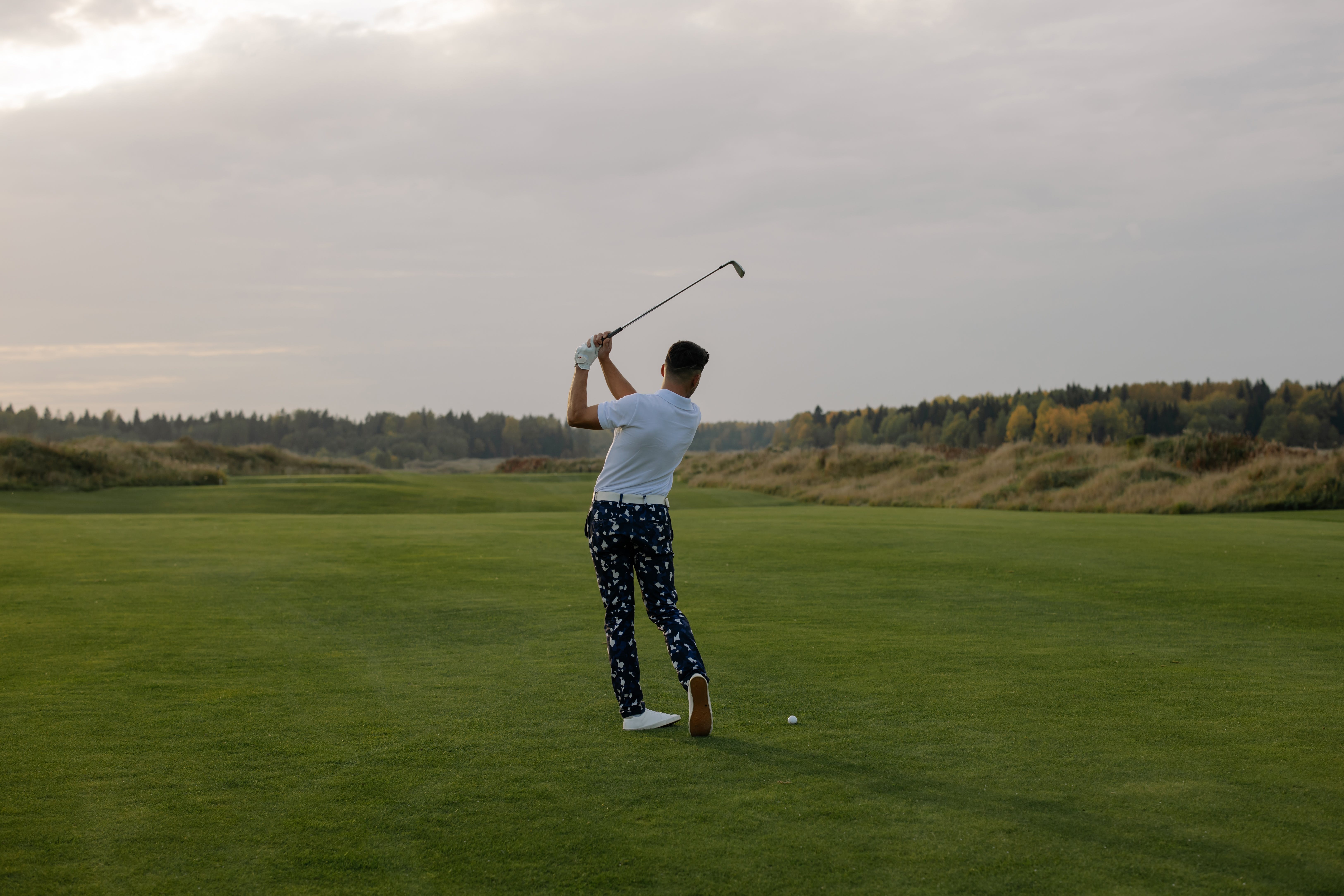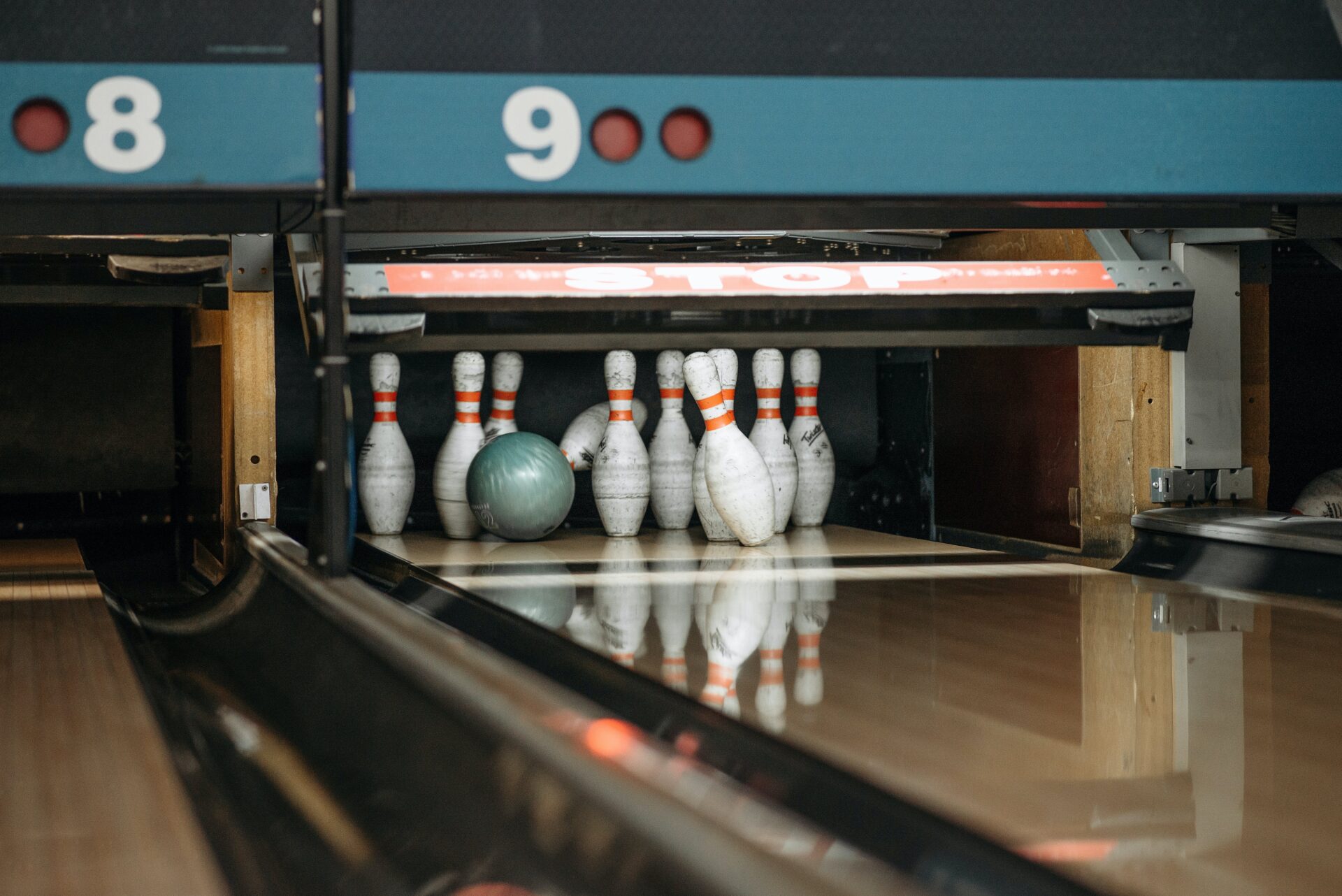Hitting behind the golf ball can be a common issue for many golfers. It can be an annoying problem that can negatively affect your game. If you’re struggling with this issue, don’t worry because there are ways to fix it. In this article, we’ll discuss how to stop hitting behind the golf ball and get back on track with your game.To improve your swing plane and stop hitting behind the golf ball, focus on keeping the clubface square throughout the entire swing. Make sure to keep your hands in front of the golf ball at all times and keep your body weight balanced throughout the swing. Increase your shoulder turn and make sure to maintain a consistent tempo throughout your downswing. Use a mirror or have a friend video record you so that you can watch for any inconsistencies. Finally, practice with purpose and make sure to focus on making solid contact with the ball.
Adjust Grip Strength to Prevent Hitting Behind Golf Ball
Hitting behind the golf ball is a common mistake made by many amateur golfers. It can be caused by several factors, but one of the most common is an incorrect grip strength. An incorrect grip strength can cause the golfer to hit behind the ball, resulting in an inaccurate shot. To prevent this from happening, it is important to adjust your grip strength to ensure that you are hitting the ball correctly.
The first step in adjusting your grip strength is to make sure that your hands are in the correct position on the club. Your thumbs should be pointing straight up and down, with your fingers curled around the handle of the club. This will help you maintain a consistent grip on the club throughout your swing. Once you have established a correct hand placement, it is important to adjust your grip strength accordingly.
If you find that you are hitting behind the ball consistently, then you should reduce your grip strength slightly. This will help make sure that when you swing, the clubface will meet with the ball at a more consistent angle and impact point. On the other hand, if you find that you are hitting too far ahead of the ball, then you should increase your grip strength slightly. This will help ensure that when you swing, the clubface will meet with the ball at a more consistent angle and impact point.
It is important to remember that adjusting your grip strength is not something that should be done every time before a round of golf or even after every shot during a round of golf; it should be done gradually over time as needed so as not to disrupt your game too much. Additionally, it is recommended that when adjusting your grip strength, always practice with an empty tee box before attempting it out on a real course. This will help ensure accuracy and consistency with each shot and prevent any embarrassing mishits due to incorrect adjustments being made during play.
Overall, adjusting your grip strength can help prevent hitting behind golf balls and improve accuracy and consistency with each shot. It is important for amateur golfers to practice regularly in order to get used to making these adjustments so they can become more comfortable with them during play on real courses
Moving Weight During Golf Swing for Better Ball Contact
Golfers should learn to move their weight correctly during their golf swings to ensure better ball contact. Moving weight correctly is important because it helps the golfer maintain balance and control throughout the swing. Proper weight shift also helps generate more power and speed, which can result in longer drives and more accurate shots.
Weight shift starts from the setup position, where the golfer should have most of their weight on their front foot. The golfer then shifts their weight back onto the rear foot at the start of the downswing and then back onto the front foot at impact. This weight shift should be smooth and steady, with no jerking or sudden movements.
The amount of weight shift will depend on a variety of factors, including strength, flexibility, and swing tempo. Generally, heavier golfers will need to shift more weight than lighter golfers due to their increased mass. As a general rule of thumb, most golfers should aim to have about 60% of their total bodyweight on their front foot at address and 40% on the back foot at impact.
Practicing proper weight shift can help golfers improve ball contact and control in their swings. It is important for golfers to practice this regularly in order to get comfortable with moving their bodies properly during the swing. Golfers should start by focusing on shifting slowly and smoothly, and then focus on increasing speed as they become more comfortable with the motion. With practice, they will eventually be able to move quickly yet still maintain balance and control throughout the swing.
Utilize Proper Posture to Avoid Hitting Behind Golf Ball
One of the most common mistakes made by golfers is hitting behind the golf ball. Hitting behind the ball results in a poor shot that lacks distance and accuracy. To avoid this mistake, it is important to ensure that you maintain proper posture when making your swing. Proper posture includes keeping your head still, keeping your arms straight and creating a slight bend in your knees. Additionally, it is important to keep your weight evenly distributed between both feet and focus on striking through the ball with an even acceleration. Keeping your head still throughout the swing will also help ensure that you are swinging in the correct direction and not hitting behind the ball.
Another key factor for avoiding hitting behind the golf ball is to make sure that you have the correct grip on the club. Having a strong grip will help ensure that you are able to control the club during your swing and make adjustments as needed. Additionally, it is important to keep your hands slightly ahead of the ball at address and maintain a constant angle during your backswing and follow through. This will help keep you from hitting behind or over-hitting the ball.
Finally, when practicing or playing on a course, it is important to pay attention to course conditions such as wind, terrain, and grass type so that you can adjust your swing accordingly. For example, if there is a strong wind blowing left-to-right then you should slightly adjust your aim towards right center of the target so that you can account for any potential drift caused by wind gusts. By taking all factors into consideration before making each shot, golfers can drastically improve their chances of avoiding hitting behind the golf ball and achieving better results on their shots.
Aim for an Inside Out Swing Path to Hit the Ball Out in Front
Hitting a golf ball out in front of you is one of the best ways to maximize your distance and accuracy. By swinging the club on an inside out swing path, you can achieve the desired impact position of having the clubhead ahead of where it was at address. This will help you hit the ball with a slightly ascending blow, which is ideal for a powerful and accurate shot.
The most important thing to remember when trying to achieve an inside out swing path is to start your backswing by taking the club away from the target line. This will help ensure that your club moves on a shallow arc towards the top of your backswing. As you reach the top, your arms should be close to parallel with your shoulders and your weight should be distributed evenly between both feet. From there, you’ll want to begin your downswing by pushing off with your trailing foot and bringing the club down on an inside out path towards impact.
It’s important to remember that hitting down on the ball is essential for maximum distance and accuracy, so make sure that you’re still descending as you make contact with it. Your arms should be fully extended at impact and aligned roughly parallel with where they were at address. If done correctly, this should produce a powerful and accurate shot that goes straight towards your target line.
Maintaining an inside out swing path throughout your entire swing can be difficult at first but it can become second nature with practice. To help ingrain this feeling into your muscles, try hitting some shots while focusing solely on keeping your hands in front of where they were at address; this will help ensure that you’re swinging from inside out every time. Once it starts becoming more natural, focus on other aspects of your game such as controlling trajectory or improving accuracy.
With practice and dedication, you can learn how to hit an optimal inside out golf swing path and achieve maximum distance and accuracy with every shot. Just remember to start by taking the club away from target line on the backswing and then bring it down in an inside out motion while still descending through impact for a powerful shot straight towards its intended target!

Increasing Swing Speed
One of the most important things to consider when trying to reduce the chances of hitting behind the golf ball is increasing swing speed. Increasing swing speed is a great way to maximize the distance and accuracy of your shots, as well as reduce the chances of hitting behind the golf ball. This can be accomplished by focusing on proper technique and making sure you are using your body correctly during the swing.
Stance and Setup
The first step in increasing your swing speed is by adjusting your stance and setup. This includes addressing the ball correctly and making sure you have a good posture throughout your swing. Make sure that you are standing upright with your feet shoulder-width apart, and that you are keeping your arms close to your body in order to maintain control during the entire motion. Additionally, make sure that you are keeping your head down and looking at the ball as you take the club back for a full swing.
Weight Transfer
A key component in increasing swing speed is proper weight transfer during the backswing. Make sure that you are shifting your weight from one side to another as you take a full backswing, allowing for more power when driving through impact. Additionally, make sure that you are using both arms equally throughout the entire motion, as this will help keep things balanced and provide consistency from shot to shot.
Grip Pressure
Another important factor in increasing swing speed is maintaining proper grip pressure throughout each shot. Make sure that you have a light grip on both hands when taking a full backswing, as this will allow for maximum clubhead speed at impact while still providing enough control to hit accurate shots. Additionally, make sure that you are not gripping too tightly or too loosely on either hand in order to maintain consistent contact with the clubhead throughout each shot.
By properly adjusting stance and setup, utilizing proper weight transfer techniques, and maintaining correct grip pressure, golfers can effectively increase their swing speed while reducing their chances of hitting behind the golf ball. With practice and dedication, anyone can learn how to maximize their potential while minimizing inconsistencies on each shot.
Focus on Follow Through for Optimal Impact on the Ball
When you are practicing your golf swing, one of the most important aspects to consider is the follow through. The follow through is the phase of your swing that occurs after impact with the ball. It is essential to focus on this part of your swing in order to achieve optimal impact with the ball.
The follow through should begin as soon as you make contact with the ball. This means that it should start with a smooth, controlled movement that will ensure that you maintain control over the club head and direct it in a desired direction. As you continue your swing, it is important to keep your arms and elbows straight and maintain a consistent speed throughout the entire motion.
At the end of your follow through, it is important to finish in a balanced position. This means that your feet should be shoulder-width apart and slightly bent at the knees, while your hips and torso should remain square to the target line. Finishing in a balanced position will help you create more power and accuracy with each swing.
In addition to focusing on form during practice sessions, it is also important to monitor how well you are executing your follow through during actual rounds. Pay attention to how much power and precision you are creating with each shot and make adjustments accordingly if needed. With consistent practice, you can develop an effective follow through technique that will help you achieve maximum impact on each shot.
By paying close attention to your follow through during practice sessions, you can ensure that when it comes time for game play, you have developed an efficient technique for achieving optimal impact with each shot. With regular practice and monitoring of results during rounds, you can eventually develop a reliable follow-through technique that will give you greater control over each shot’s trajectory and distance traveled.
Keep Flexible and Maintain Balance Throughout Golf Swing
Maintaining balance and flexibility throughout a golf swing is essential in order to increase your performance on the course. By keeping your body in a relaxed position, you can create more power and speed while also improving accuracy. Staying flexible allows you to move freely and generate more clubhead speed with less effort. Ensuring that you keep your balance as you swing helps to ensure that your body is in the correct position at all times during the swing, making it easier to hit a consistent shot.
To ensure that you remain flexible throughout your golf swing, it is important to warm up properly before you start playing. Stretching exercises can help to loosen up your muscles and joints, allowing them to move freely during the swing. Warming up also helps increase blood flow which can improve range of motion and reduce fatigue. Additionally, performing dynamic stretches such as arm circles or torso twists helps activate muscles that will be used during the golf swing.
Maintaining balance throughout the golf swing is also key for optimal performance on the course. Keeping your weight distributed evenly between both feet will help create stability and keep you from falling off balance during the swing. Practicing with a weighted club or medicine ball can help improve core strength which will also aid in maintaining balance while swinging. Additionally, focusing on keeping your head still throughout the swing will help keep everything else in place as well.
By staying flexible and maintaining balance throughout a golf swing, players can ensure that they are able to generate maximum power without sacrificing accuracy or consistency on their shots. Taking time to properly warm up before playing is essential for staying flexible while also improving core strength will help maintain balance throughout each shot. With practice and dedication, players can maximize their potential on the course by learning how to stay flexible and balanced during their swings.

Conclusion
Hitting behind the golf ball is a common issue and can be resolved by making some minor adjustments to your swing. First, make sure you are taking the club back on a level plane and not too much from inside-out. Second, start your downswing with your lower body and not too early with your hands. Finally, let the clubhead pass your hands before you strike the ball. With these simple adjustments, you should be able to stop hitting behind the golf ball.
It’s important to remember that it takes time and practice to become a better golfer. Don’t expect results overnight, but if you stay consistent with these techniques then you should see improvement in no time. With dedication and hard work, you can take your game to the next level!




